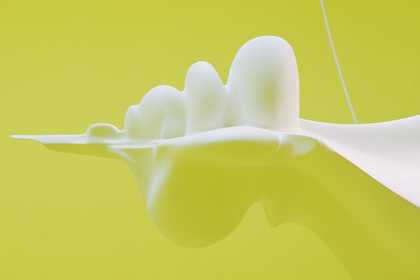Himali: I'm Himali, I'm a poet and a performer
David: And I'm David, I'm a musician and artist. And together we’re Hylozoic/Desires.
Himali: Hylozoic is the philosophical doctrine that a plant, a stone, a human all have equal rights to sentience. So Hylozoic/Desires is our attempt to give these different materialities a kind of consciousness
David: I think being partners in work as well as life really adds a completely different dimension in our work and I feel our work really comes out of that the collaborative aspect of our work comes out of that intimacy
Himali: So our practice is research-based and it's conceptual which means that the medium comes out of the meaning We work a lot with film because we work in very remote landscapes. And since I have a performance background I end up taking these kind of avatars and guises and become this a similar character through almost every piece that we've worked on and this character starts to build and expand. And then David often is doing field recordings in those same places and then using those recordings as inspiration to write original compositions
David: In a nutshell the Great Salt Hedge was a customs line built across the Indian subcontinent. It was 4000 kilometres long 2500 of which were planted hedge using trees and shrubs and thorny bushes to create a barrier to stop the smuggling of salt from one part that was not controlled by the British Empire into the parts that were controlled by the British Empire because they levied a huge tax on salt. So this was enormous in terms of financial impactIt was enormous in terms of its geographical expanse and it was sort of abandoned, abolished in 1879. And the crazy thing is that everybody forgot about it. At the time when it was compared to the Great Wall of China one of the kind of wonders of the world that there's this giant hedge and we thought this story needs to be told.
So we thought it was a very relevant thing to bring back. Talking about borders, talking about border controls, talking about weaponisation of nature, unnatural features.
Himali: The video's protagonist, Mayalee is inspired by a courtesan who defied the British Empire's attempts to cut off her stipends which were made in mounds of salt. Mayalee uses salt to conduct halomancy which are salt divinations. Perhaps one of her prophecies reaches across the hedge to Allan Octavian Hume the hedge’s British commissioner and changes the course of history.
We were interested in how the hedge was not a wall it was an interstitial space a mesh-like full of perforations where things got through whisperings, anticolonial dreamings.
So we created a performance as part of the installation called The Salt March and it definitely references Gandhi's Salt March during which he walked to Dandi in the state of Gujarat where the salt pans are, collected thousands and thousands of people on the way and finally reached there picked up a fist of salt during a time when the Indian subject was not allowed to even touch salt picked up a fist of salt and claimed that India would soon get its independence.
Performance is a way to activate a kind of still installation for us. It brings an embodiment to these historical characters. It makes them real. It brings a kind of proximity and danger. I think performance has a unique power shifting perspectives and playing with temporalities to take people temporarily in a completely different realm.
But just because of that energetic exchange that you have person to person, body to body in a performance context.
For us performance really is the medium that makes that possible in a very particular way.
At surface level it seems quite a benign story a story of planting and the story of plants and then to start really understanding the slow violence that we have undergone historically, archivally, ancestrally but that we still live with today.
David: I think it's also important for me that while kind of understanding and appreciating the historical context people also make the connection to our present moment and think about this sort of what Himali calls the ripples of time. What are the violences that we continue perpetrating?
Perhaps not in the same context perhaps not in the same place but the kind of violent ideas from that time that we have carried forward and how can we become conscious of that as a first step in trying to change things.
Himali: As someone from the subcontinent it feels like even decades ago we had no space or place in galleries like that. So one can't help feeling honoured and humbled by it but also the responsibility of that is immense. And we hope that just one blast of a tuba at a time, it can seep in some way.



